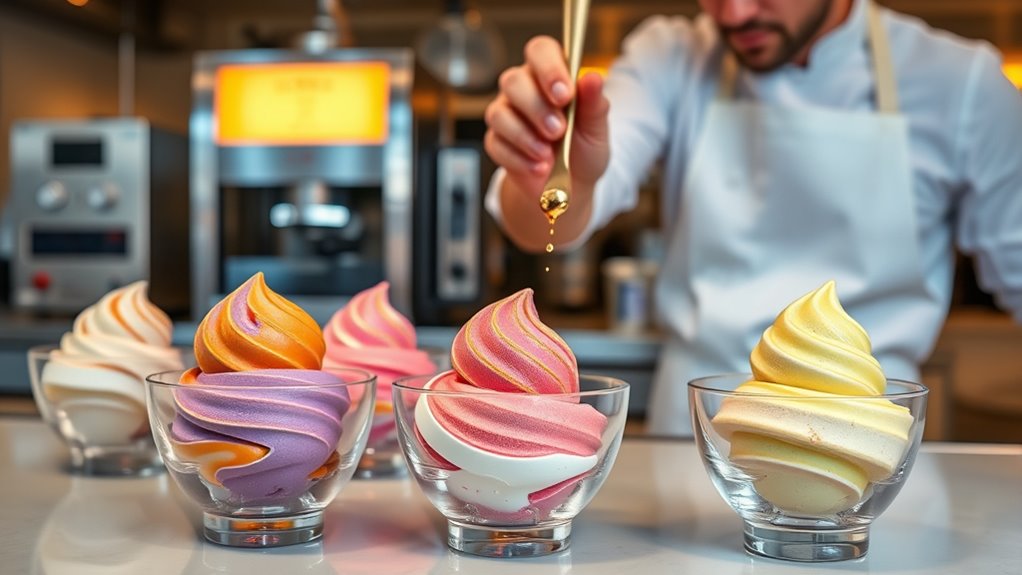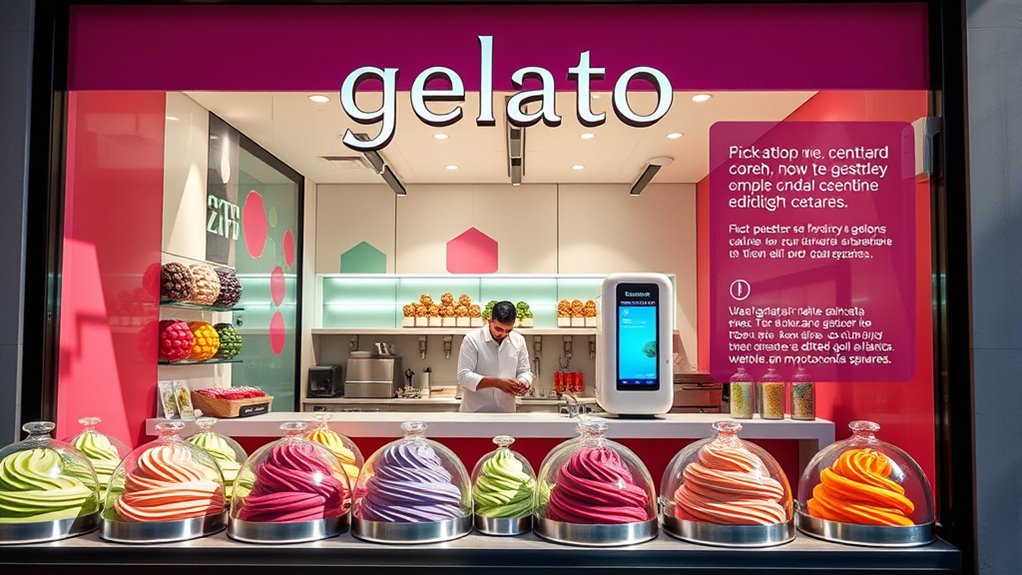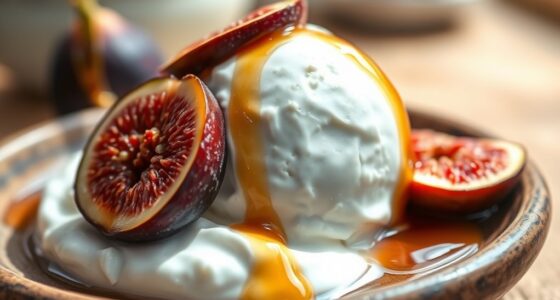American gelato makers are pushing boundaries by blending global flavors, creating innovative hybrid varieties, and focusing on health-conscious ingredients. You’ll find plant-based options, bold international influences like matcha and yuzu, and unique combinations such as ruby chocolate with bourbon. They also craft low-sugar and functional treats catering to evolving tastes. If you want to discover the latest trends and creative flavors shaping the American gelato scene, keep exploring what’s next in this exciting market.
Key Takeaways
- Introduction of plant-based gelato options made from oat, almond, coconut, and cashew for health-conscious consumers.
- Fusion of international flavors like matcha, yuzu, and chai, inspired by global culinary trends.
- Creation of innovative hybrid flavors, such as ruby chocolate with bourbon, showcasing American artisanal creativity.
- Development of low-sugar and functional gelato varieties catering to health and dietary needs.
- Personalization and cultural influences integrated into flavor development and branding to enhance consumer engagement.

American gelato makers are transforming the frozen dessert scene by embracing innovation and consumer preferences. The market is booming, driven by the demand for gelato innovation that aligns with health-conscious and globally inspired tastes.
American gelato makers are revolutionizing frozen desserts through innovation and consumer-driven flavors.
You’ll notice a surge in plant-based gelato varieties, crafted from oat, almond, cashew, coconut, and peanut bases. These vegan ice cream options appeal to those seeking dairy-free, sustainable, and nutritious treats. As a result, plant-based gelato isn’t just a niche—it’s becoming a staple in many shops, offering rich textures and bold flavors without animal products.
Regional flavors are also taking center stage, reflecting America’s diverse culinary landscape. You might find matcha from Japan, yuzu from Japan, churro-inspired options, or chai flavors, often paired with familiar tastes like vanilla. These local and international influences help reduce consumer hesitation, making exotic flavors more accessible and appealing.
This trend of incorporating regional flavors signifies a shift towards more globally inspired gelato products that resonate with adventurous palates seeking authentic taste experiences.
Hybrid flavors are another exciting development. Gelato brands are experimenting with limited-edition and innovative combinations, like ruby chocolate mixed with bourbon or unexpected ingredients that elevate indulgence. These new gelato products showcase the creativity of American artisans, pushing the boundaries beyond traditional flavors.
Consumers can enjoy unique, memorable experiences with every spoonful, fueling the movement toward more diverse and sophisticated flavor trends.
The focus on low-sugar desserts is evident in the rise of health-oriented options. Brands are developing gelato that satisfies sweet cravings without overwhelming sugar content, appealing to those managing health or dietary restrictions.
Alongside this, the trend toward functional, nourishing, and on-the-go gelato formats caters to busy lifestyles, providing convenient yet indulgent treats for consumption anytime, anywhere. These portable options include smaller packaging or innovative formats designed for easy enjoyment, aligning with the broader shift in American frozen desserts.
Additionally, the incorporation of astrological influences in flavor development and branding strategies is subtly gaining popularity, tapping into consumer interest in personalized and culturally resonant experiences.
Frequently Asked Questions
What Is the Difference Between American Gelato and Italian Gelato?
You might notice that American gelato has a creamier texture and higher butterfat content compared to Italian gelato, which is denser and more intensely flavored with less fat.
American versions often feature innovative flavors and mix-ins, while Italian gelato focuses on traditional recipes with natural ingredients.
Additionally, American gelato uses faster freezing methods and stabilizers for stability, whereas Italian gelato emphasizes artisanal, small-batch production.
Can You Get Real Gelato in the US?
Yes, you can get real gelato in the US. You’ll find it mainly in specialty shops and high-end grocery stores, especially in big cities like New York, Los Angeles, and Chicago.
These places often serve authentic Italian-style gelato made with imported ingredients and traditional methods. While not everywhere, dedicated gelaterias and upscale markets make it accessible, giving you the chance to enjoy the dense, creamy texture of genuine Italian gelato.
What Country Makes the Best Gelato?
You might think your favorite country makes the best gelato, but surprise—Italy still holds that crown. With centuries of tradition, Florence and Bologna craft dense, creamy masterpieces that set the global standard.
While others try to catch up, Italy’s authentic ingredients and time-honored methods keep its gelato unmatched. So, when it comes to the best, Italy’s rich heritage makes it the real winner—no contest needed.
Who Brought Gelato to America?
You might wonder who brought gelato to America, and it’s Italian immigrants who introduced this delicious treat. They arrived in the late 19th and early 20th centuries, opening the first gelato shops in cities like New York and Chicago.
Italian-American entrepreneurs continued to popularize gelato through family-run businesses, blending authentic recipes with local ingredients. Their efforts helped establish gelato as a beloved dessert across the United States today.
Conclusion
As you explore these American innovations in gelato, you’re stepping into a world where tradition dances with creativity. Each scoop becomes a brushstroke on a vibrant canvas, blending old-world charm with modern twists. So, next time you savor a gelato, remember you’re tasting a symphony of innovation, crafted with passion and daring. Embrace the flavors, and let each spoonful transport you to a melting pot of sweet possibilities.









